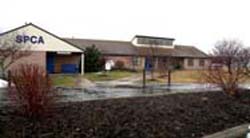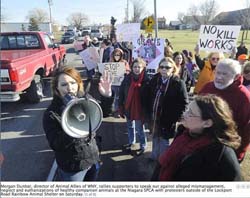Niagara Falls, SPCA Must Agree on Price for Animal Control Services
By Tony Farina
 |
 |
If it wasn't for her.... Media savvy and aggressive, Morgan Dunbar led protestors time and again to secure changes at the Niagara County SPCA. |
 |
SPCA Board President Michelle Madigan. |
 |
Who's right and who's wrong in the current fight over money between the cash-strapped Niagara SPCA and the similarly cash-short city of Niagara Falls?
Perhaps more importantly, what will happen if the SPCA cuts off non-emergency animal control services to Niagara Falls that it says it can no longer provide under the contract that expired at the end of 2011 because it is losing about $150,000 a year under that agreement? And what will happen to the shelter's highly praised no-kill efforts if it can't raise enough money to fund operations from a city like Niagara Falls that it services. And has the city flip-flopped on its support for no kill, as suggested in the latest contract proposal from the administration.
The give-and-take between the city and the shelter over the last 18 months culminated when the frustrated SPCA Board of Directors voted last Wednesday - the date (July 10) established as a final deadline to reach an agreement - to cease all services to the city effective July 15 after the mayor failed to personally take part in a previously arranged conference call to discuss a new deal.
The parties were in court last week as the city sought an order to stop the SPCA from cutting off dog control services and State Supreme Court Justice Richard Kloch signed a restraining order halting the action and scheduled a hearing for Thursday (July 18) to take up the high-stakes dispute.
Only one SPCA board member, David Bower did not take part in the board's actions voting to stop services to the city, saying he didn't agree "with slamming the door on the city on just four days notice," and that he is calling on the two sides to get back to the table and work out a new agreement in the best interests of all concerned.
Bower acknowledges the SPCA has been under extreme financial pressure since adopting a no-kill policy last year, saying "the support from the community just hasn't been there," even though it was widely praised when the shelter moved to a save rate of better than 90 percent, a far cry from the brutal policies of the past that were exposed in a scathing report detailing animal abuse and mismanagement at the shelter prepared by Barbara Carr, the highly respected executive director of the Erie County SPCA.
While Mayor Paul Dyster has expressed support for the no-kill mission prior to the current fight, most recently in a letter dated July 3, he said he hoped the SPCA would understand that while sympathetic to the SPCA's financial challenges under no kill, "we face our own difficulties and dilemmas. We face our own limitations in terms of our ability to fund [the SPCA]." The city's latest contract proposal supports euthanizing animals after only five days.
The dollar amounts separating the two sides are significant. The shelter wants $15,000 a month from the city to bring the contract in line with actual costs, saying under the current arrangement it is losing $150,000 a year and can no longer afford to keep servicing animal control for a high-need dog population at the expense of other shelter animals and overall operations.
There is little doubt that without the SPCA's services, the city would go to the dogs and be forced to resort to unthinkable and most certainly inhumane methods to control the animal population in the city.
Corporation Counsel Craig Johnson offered a "no comment" response to questions about whether negotiations have resumed before Thursday's scheduled court hearing. SPCA Board President Michelle Madigan could not be reached for comment.
People across Western New York were shocked and appalled when the reports of animal cruelty at the Niagara SPCA were first reported by the Niagara Gazette. The follow-up investigation by Barbara Carr confirmed the horror that was taking place at the shelter, and amid great fanfare a new era humane animal care was established at the shelter under the umbrella of the no kill movement.
The sad reality, according to Bower, is that volunteer contributions to the Niagara SPCA have been far below what was expected when the new policy was announced, and the shelter is currently struggling to make ends meet. That is certainly not good news for animal lovers who staged massive protests when the reports were first made public about the conditions at the shelter.
It would seem that Niagara Falls, as the largest city in the Niagara SPCA territory, must shoulder its responsibility to animal control in the city and find common ground with the struggling shelter to make sure it is paying its share for the services it is receiving. That's the number the two sides must agree on, and hopefully Judge Kloch will be able to help establish a dialogue that will lead to a resolution of the dispute that is threatening to unravel animal control and humane shelter service that everybody said they wanted when the animal death camp reports first surfaced.
The city's proposal to undo no kill over money seems like a move that should meet with strong opposition from no kill supporters and we would certainly hope for a more humane solution to the problem rather than returning the shelter to a killing factory.